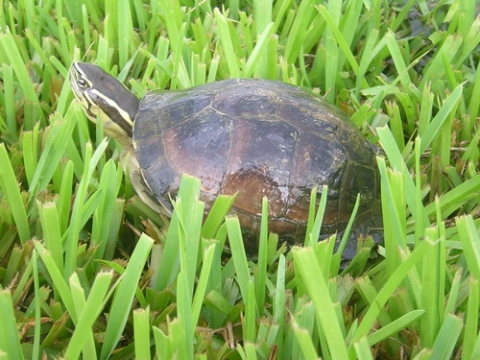The Malayan box turtle requires an aquarium that provides a water area and a land area in approximately a 50:50 ratio. Box Turtles FOR SAL A 30gal long (36x18x12) is a minimum size for one juvenile individual. The “long” format allows for more surface area, and you don’t need the greater depth of the standard 30-gal tank.Box Turtles FOR SAL Make sure to provide enough water for swimming, at least 6″ deep. Place a reptile light fixture on the tank, and provide some other type of basking and warming lamp. Use of substrate is optional. Pea gravel can be very attractive and natural looking. Gravel can also aid in keeping the water clean, if an undergravel filter is used. Additional rocks, wood and plants make nice additions to an aquarium.
A reliable water heater is required. Keep the water temperature between 79 and 84 degrees F. (26.1 – 29 C.) Cover the tank enough to maintain a high humidity level (in the tropical range, 75-90%) and an air temperature of at least 78 degrees F, (25.6 C.) The area under the warming light should be about 82 to 90 degrees F. (28 – 32.3C) during the day.
Malayan is somewhat like other box turtles–omnivorous. However, aquatic plants provide the main food source for C. amboinensis in the wild. Provide a variety of greens ‘n veggies, some fruits, mushrooms and an occasional waxworm or cricket. “Gut loading,” or feeding nutritional plant matter to the worms or crickets before offering them to the turtle, improves the quality of this food source. Use a good supplement, formulated for turtles, to assure proper nutrition.
Malayans prefer to feed in the water, if the water is warm enough. Aquatic plants and greens can be provided in the pond or aquarium at all times. Feeding in a sink or plastic tub away from the aquarium will make cleaning easier. Healthy, well-nourished turtles do not require large feedings on a daily basis. It is a good idea to keep cuttlebone, or some other high calcium food, available all the time. Turtles should not be fed spinach, rhubarb or parsley as these are high in oxalic acids, which can cause calcium deficiency.
A reliable water heater is required. Keep the water temperature between 79 and 84 degrees F. (26.1 – 29 C.) Cover the tank enough to maintain a high humidity level (in the tropical range, 75-90%) and an air temperature of at least 78 degrees F, (25.6 C.) The area under the warming light should be about 82 to 90 degrees F. (28 – 32.3C) during the day.
Malayan is somewhat like other box turtles–omnivorous. However, aquatic plants provide the main food source for C. amboinensis in the wild. Provide a variety of greens ‘n veggies, some fruits, mushrooms and an occasional waxworm or cricket. “Gut loading,” or feeding nutritional plant matter to the worms or crickets before offering them to the turtle, improves the quality of this food source. Use a good supplement, formulated for turtles, to assure proper nutrition.
Malayans prefer to feed in the water, if the water is warm enough. Aquatic plants and greens can be provided in the pond or aquarium at all times. Feeding in a sink or plastic tub away from the aquarium will make cleaning easier. Healthy, well-nourished turtles do not require large feedings on a daily basis. It is a good idea to keep cuttlebone, or some other high calcium food, available all the time. Turtles should not be fed spinach, rhubarb or parsley as these are high in oxalic acids, which can cause calcium deficiency.
